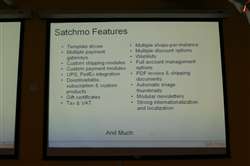Ars at DjangoCon: Day one round-up (original) (raw)
After a great morning talk by Guido van Rossum's inspiration from and application of Django's role in Google App Engine, the crowd of 200 attendees broke into two tracks for the rest of the day.
I was able to attend a session on Satchmo, a web store built on Django that's surprisingly configurable and robust. The package ships with a number of shipping and payment models and can be configured for a wide range of sellable products (physical items with many configurations, downloadable products, et cetera). The team is currently focusing on releasing a 1.0 version with a revamped product system and a focus on a cleaner administrative interface now that the newforms-admin branch of Django was merged to trunk for 1.0.
Adrian Holovaty, BDFL of Django
The second session I attended was on the State of Django, a talk given during lunch by two of the projects co-founders: Adrian Holovaty and Jacob Kaplan-Moss. They wound through the beginnings of Django at a small newspaper in Kansas and showed off some of the first commits and code from their internal code repository. It was a light-hearted explanation of some of the original design decisions and how the project has gotten from its humble beginnings to the mass of code checked into the project for the push to their first stable version. For those curious it breaks down like this:
About half of the code that’s gone into Django over the past three years has been contributed by someone other than a core committer. Since our last stable release, we’ve made over 4,000 code commits, fixed more than 2,000 bugs, and edited, added, or removed around 350,000 lines of code. We’ve also added 40,000 lines of new documentation, and greatly improved what was already there.
James Bennett, Django Release Manager
The third session I attended was a talk given by Django's release manager, James Bennett, titled Reusable Applications. Django's philosophy of small, encapsulated bits of functionality that can be mixed and matched between projects are called applications. Django (and Python's) architecture encourages this sort of design methodology which James refers to as Django's "killer feature." James covered much of what he wrote in his book, Practical Django Projects (Ars review), but expanded his thoughts on best design practices, documentation driven development, and packaging.



